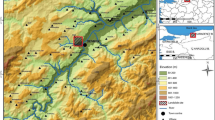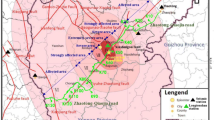Abstract
Realistic prediction of seismic landslides is critical for performance-based design in the seismically active regions. To date, analytical methods for estimating seismic landslides have been based on simplified models. Many gaps still remain in the scientific understanding of earthquake-induced landslides, especially the landslide triggering process and post-failure behavior. In this study, a strain-softening fully nonlinear dynamic soil model is formulated using the material point method (MPM) to simulate the soil slopes failure process under dynamic loading. The study demonstrated that MPM can capture entire slope failure process, including slide triggering, shear band formation, runoff and final deposition. The complicated interaction between sliding masses can also be captured. Numerical simulation also demonstrated that residual soil strength is an important factor in determining landslide runoff and deposition. The study demonstrated the great promise of MPM method in improving our understanding of the coseismic landslide process and these underlying influential factors.
Access this chapter
Tax calculation will be finalised at checkout
Purchases are for personal use only
Similar content being viewed by others
References
Abe K, Shinoda M, Watanabe K, Sanagawa T, Nakajima S, Nakamura S, Kawai T, Murata M, Nakamura H (2012) Numerical simulation of landslides after slope failure using MPM with SYS Cam-clay model in shaking table tests. In: Proceedings of 15th world conference on earthquake engineering
Abe K, Soga K, Bandara S (2013) Material point method for coupled hydromechanical problems. J Geotech Geoenviron Eng 140(3):04013033
Andersen S, Andersen L (2010) Modelling of landslides with the material-point method. Computat Geosci 14(1):137–147
Bandara S, Soga K (2015) Coupling of soil deformation and pore fluid flow using material point method. Comput Geotech 63:199–214
Bardenhagen SG, Kober EM (2004) The generalized interpolation material point method. Comput Model Eng Sci 5(6):477–496
Bhandari T, Hamad F, Moormann C, Sharma KG, Westrich B (2016) Numerical modelling of seismic slope failure using MPM. Comput Geotech 75:126–134
Du W, Wang G (2016) A one-step Newmark displacement model for probabilistic seismic slope displacement hazard analysis. Eng Geol 205:12–23
Du W, Huang D, Wang G (2018a) Quantification of model uncertainty and variability in Newmark displacement analysis. Soil Dyn Earthq Eng 109:286–298
Du W, Wang G, Huang D (2018b) Influence of slope property variabilities on seismic sliding displacement analysis. Eng Geol 242:121–129
Huang D, Wang G, Du C, Jin FS, Feng K, Chen Z (2020) An integrated SEM-Newmark model for physics-based regional coseismic landslide assessment. Earthq Eng Soil Dyn 132:106066
Jibson R (2007) Regression models for estimating coseismic landslide displacement. Eng Geol 91:209–218
Liang W, Zhao J (2019) Multiscale modeling of large deformation in geomechanics. Int J Numer Anal Meth Geomech 43(5):1080–1114
Massey C, Townsend D, Rathje E et al (2018) Landslides triggered by the 14 November 2016 Mw 7.8 Kaikōura Earthquake, New Zealand. Bull Seismol Soc Am 10(3B):1630–1648
Soga K, Alonso E, Yerro A, Kumar K, Bandara S (2016) Trends in large-deformation analysis of landslide mass movements with particular emphasis on the material point method. Géotechnique 66(3):248–273
Sulsky D, Chen Z, Schreyer HL (1994) A particle method for history-dependent materials. Comput Methods Appl Mech Eng 118(1–2):179–196
Wang G, Xie Y (2014) Modified bounding surface hypoplasticity model for sands under cyclic loading. J Eng Mech ASCE 140(1):91–101
Wang ZL, Dafalias YF, Shen CK (1990) Bounding surface hypoplasticity model for sand. J Eng Mech 116(5):983–1001
Wang B, Vardon PJ, Hicks MA (2018a) Rainfall-induced slope collapse with coupled material point method. Eng Geol 239:1–12
Wang G, Du C, Huang D, Jin F, Koo RCH, Kwan JSH (2018b) Parametric models for 3D topographic amplification of ground motions considering subsurface soils. Soil Dyn Earthq Eng 115:41–54
Więckowski Z (2004) The material point method in large strain engineering problems. Comput Methods Appl Mech Eng 193(39–41):4417–4438
Xu C, Ma S, Tan Z, Xie C, Toda S, Huang X (2018) Landslides triggered by the 2016 Mj 7.3 Kumamoto, Japan, earthquake. Landslides 15:551–564
Yin YP, Wang FW, Sun P (2009) Landslide hazards triggered by the 2008 Wenchuan earthquake, Sichuan, China. Landslides 6:139–152
Acknowledgements
This study is supported by General Research Fund 16214519 from Hong Kong Research Grants Council and research fund 2019-KY-02 from State Key Laboratory of Hydroscience and Engineering.
Author information
Authors and Affiliations
Corresponding author
Editor information
Editors and Affiliations
Rights and permissions
Copyright information
© 2021 The Author(s), under exclusive license to Springer Nature Singapore Pte Ltd.
About this chapter
Cite this chapter
Wang, G., Feng, K., Huang, D. (2021). Large Deformation Analysis of Coseismic Landslide Using Material Point Method. In: Sitharam, T., Jakka, R., Kolathayar, S. (eds) Latest Developments in Geotechnical Earthquake Engineering and Soil Dynamics. Springer Transactions in Civil and Environmental Engineering. Springer, Singapore. https://doi.org/10.1007/978-981-16-1468-2_10
Download citation
DOI: https://doi.org/10.1007/978-981-16-1468-2_10
Published:
Publisher Name: Springer, Singapore
Print ISBN: 978-981-16-1467-5
Online ISBN: 978-981-16-1468-2
eBook Packages: EngineeringEngineering (R0)




